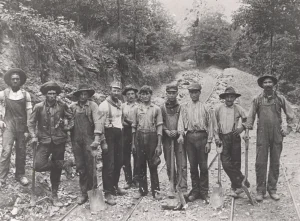A History of the New York Gypsum Industry, 1790-1930


 New York State has been identified with the American gypsum industry from its start. The deposits in the central counties, where the gypsum [calcium sulfate] outcrops in places on the surface, were noted by the early settlers who began to take active possession of the lands… during the closing years of the eighteenth century.
New York State has been identified with the American gypsum industry from its start. The deposits in the central counties, where the gypsum [calcium sulfate] outcrops in places on the surface, were noted by the early settlers who began to take active possession of the lands… during the closing years of the eighteenth century.
The settlers were mostly from eastern New York and New England. They had some acquaintance, no doubt with the agricultural uses of gypsum, which at that time was imported and employed quite· extensively in the farming sections along the coast. This material came from Nova Scotia and France, for there were no local sources of supply in the coastal area.
The first discovery of gypsum in the state, and possibly the first on record within the country, is generally credited to William Lindsay of the town of Camillus, Onondaga County, in 1792.
The· name Camillus is still linked appropriately with the geological name for the beds which contain the commercial resources of gypsum. Some interesting particulars about the discovery have been given by J. V. H. Clark in his history of Onondaga County [1849].
“The first plaster discovered in the United States was in this town by William Lindsay in 1792. His attention was accidentally arrested by a portion of the white semi-translucent rock projecting from the side hill, a little south of Camillus village, on lot number ninety.
“A large block of it was taken to his house and examined by sundry persons, who at the time were unable to determine what it was. It was at length ascertained it was plaster and equal to that brought from Nova Scotia.”

 By 1812 the beds had been thoroughly opened and exposed and large quantities in the stone were carried off eastward and to the southern tier of counties. Since which, the trade has been flourishing and lucrative.
By 1812 the beds had been thoroughly opened and exposed and large quantities in the stone were carried off eastward and to the southern tier of counties. Since which, the trade has been flourishing and lucrative.
A few years later the deposits of Madison County were brought to notice as has been recorded by J. E. Smith [1899]:
“Gypsum was discovered about the beginning of the present century [19th] by Jacob Patrick on the farm owned in recent years by John Lillie, about three-fourths of a mile east of Chittenango, and was brought into commercial importance during the War of 1812 and the embargo preceding it [the Embargo Act of 1807], when Nova Scotia plaster was excluded from the markets of the country.
“A plaster bed was opened here, probably as early as 1810. Thousands of tons of gypsum was quarried here, most extensively on the farm of Captain Timothy Brown.”
No use was made of gypsum in the early days for calcined plaster [a powdered form of plaster of Paris], all of the output finding employment on the land [as a soil amendment, conditioner and fertilizer].
Strangely enough, its value for the latter purpose seems to have met with greater appreciation by local farmers, as well as by those living at considerable distances from the sources of supply, than at the present day when the material is obtainable at relatively lower prices and the land by reason of long tillage is probably of inferior fertility.
Its place has been taken to a great extent by ground limestone and phosphates, although these may not exactly fill the purpose which gypsum serves.
The deposits near Union Springs, Cayuga County, were important for agricultural plaster from 1811, the year of discovery, down to 1900 or a little later.

 Their situation on Cayuga Lake, with Erie Canal connections, gave access at low freight rates to the important markets along the Mohawk and Hudson valleys and to the western end of the State. Ground gypsum was shipped to points as distant as Philadelphia.
Their situation on Cayuga Lake, with Erie Canal connections, gave access at low freight rates to the important markets along the Mohawk and Hudson valleys and to the western end of the State. Ground gypsum was shipped to points as distant as Philadelphia.
By 1838, when the first geological survey of New York was in progress, gypsum quarries had been established in Monroe, Ontario, Cayuga, Onondaga and Madison counties. The yearly product at that time was placed by Beck at about 50,000 tons, a rate of production that subsequently was scarcely exceeded until the beginning of the present [20th] century.
Of the places mentioned in the first reports of the survey as prominent in the industry only those in the town of Wheatland, Monroe County, have maintained their importance down to the present time. The more exacting requirements of the calcined plaster trade, now the chief outlet for the mineral, have changed the status of the producing industry and confined its activity largely to the western end of the field.
Experiments in calcination of the local gypsum may have been undertaken by some of the early producers, but there arc no accounts of the commercial manufacture of calcined gypsum in the district until much later, about a century after the first discovery.
Wilder in his account of the beginnings of the calcined plaster business, mentions New York as the earliest source of knowledge in the technology of plaster. He undoubtedly has reference to plants situated in the environs of New York City which imported rock from Nova Scotia for manufacture.
They were probably the first establishments of the kind in the country. Calcining plants were later built in Michigan and Iowa to utilize the gypsum in those states and they had been in operation many years before the first commercial undertaking in the Salina district was started.
The reports of the United States Geological Survey credit New York with a production of calcined gypsum from domestic rock in 1892, which may be taken as the date of the beginning of the local industry.

 The original calcining enterprise in the Salina belt, so far as is known, and the direct predecessor of the present extensive manufacturing operations on the basis of the local gypsum deposits, was set up by William D. Olmstead, who started at Oakfield [in Genesee County] with a single kettle.
The original calcining enterprise in the Salina belt, so far as is known, and the direct predecessor of the present extensive manufacturing operations on the basis of the local gypsum deposits, was set up by William D. Olmstead, who started at Oakfield [in Genesee County] with a single kettle.
Mr. Olmstead had carried on land plaster manufacture there for many years, obtaining the necessary lump gypsum from shallow mines worked through a vertical shaft, which was likewise an innovation in the New York district.
The experiment showed the practical adaptability of the Oakfield gypsum to calcination, and the output found a ready market in competition with foreign material. The operations were enlarged in the succeeding years, but it was not until the opening of the present century that they began to assume considerable proportions.
In 1903 the United States Gypsum Company [now the largest distributor of wallboard in the US and the largest manufacturer of gypsum products in North America] entered the New York field and brought financial resources, as well as a command of technical experience from older established enterprises, that greatly helped to stabilize the industry during its formative pcri0rl. The original Oakfield plants were taken over and their operations consolidated.
The outgrowth of improvements and reconstruction extending over many years is to be found in the present unit at Oakfield, the largest in the company’s chain, if not altogether unique for the scale of its mining and manufacturing equipment.

 During recent years the record activity of the building trades has stimulated progress. The use of gypsum in these lines has expanded even more rapidly than the statistics of building volume from year to year would seem to indicate, for the reason that gypsum materials have gained at the expense of other kinds.
During recent years the record activity of the building trades has stimulated progress. The use of gypsum in these lines has expanded even more rapidly than the statistics of building volume from year to year would seem to indicate, for the reason that gypsum materials have gained at the expense of other kinds.
This is particularly the case in modern fireproof construction in which gypsum is used much more extensively than a few years ago. New forms of materials have been perfected, also, for frame buildings that have increased the relative consumption.
It would appear that the possibilities of the adaptation of gypsum to such uses have not yet been fully realized.
Read more industrial history of New York State.
This essay was first published “The Gypsum Resources and Gypsum Industry of New York,” New York State Museum Bulletin No. 283, November, 1929. It has been annotated and images added by John Warren.
Illustrations, from above: Gypsum miners in Garbutt, town of Wheatland (Wheatland Historical Society); Inside a gypsum mine in Ohio, ca 1910; an inaccurate historic sign installed by William Pomeroy Foundation; The US Gypsum Company plant in New Brighton, Staten Island, on the Kill van Kull, 1895; and the modern gypsum plant of Saint-Gobain North America on the Hudson River in Buchanan, Westchester County.
Source link




